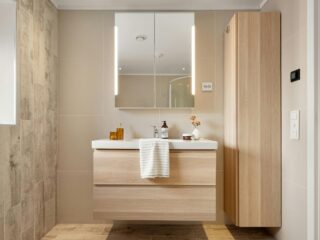
Once upon a time, a gaming room revolved around features like pool tables, foosball, and massive L-shaped couches. Today, gaming is overwhelmingly connected with technology—which means those computer rooms have now fused with gaming rooms. Regardless of what type of interior the rest of your house has, it’s difficult to find a balance when arranging a useful and tasteful gaming room.
Though gamers will most likely be focused on playing their favorite titles, a functional game room includes a lot more than a TV and a PlayStation. The challenge lies in meeting all the needs of the gamers in your household, while also being mindful of decor, furniture, and comfort. In other words, can you create a gaming room that people will actually spend time in? Or will it be relegated to a corner of the house and forgotten?
If you want to create a subtle and functional gaming room, we’ve got a few insider tips for you.
Monitors Go the Distance
One of the first questions you need to ask when creating a gaming room is what types of gaming equipment are necessary. To give a few examples, gamers today might use one or several platforms, including a PlayStation, Xbox, Nintendo Switch, Oculus Quest, tablet, or even a PC. Consider, for example, a game like blackjack.
Though not clumped with traditional video games, blackjack is a hugely popular title that can be found on virtual platforms that offer casino games. As with any other game, players are apt to spend hours focused before a screen as they hit and split their way to a win. It’s important to consider what types of games will be played, and how players will access them.
By far the most robust solution is to have a large monitor or a projector available. A single monitor with an HDMI port is accessible to every type of gaming hardware outlined above. No matter what type of gaming equipment your household uses, a monitor is the easiest way to cater to gamers without shoving a TV into the room as well. The same goes for projectors, though they’re a bit pricier and more complex than a standard monitor.

Seating is the Secret
Once you’ve figured out what types of gaming equipment you’re going to use, the next element to focus on is arrangement. Any room needs to be tastefully balanced to create a sense of flow—but this is particularly important for gaming rooms. Seating is one of the most critical elements of comfort for gamers. How will they sit when they play? And how many gamers expect to play at the same time?
Once again, gaming equipment should steer your outlook. For console and PC gamers who will be sitting before a monitor, consider investing in one or two ergonomic gaming chairs. On the other hand, if you plan to entertain gamers who like handheld devices or tablets, then a more lounge-friendly couch seat or love seat will provide the ultimate comfort.
Let’s look at another example to explore handhelds versus monitor-based games, like we did with blackjack. A handheld device like a Steam Deck is designed to pack the power of a PC into a much smaller computer, meaning many players focus on expansive RPGs like the newly released Diablo IV. This game allows players to delve into a medieval fantasy world filled with monsters that get progressively more difficult to destroy. The game’s magic is in its details, which players will have hours and hours to pore over.
Unlike blackjack players, however, handheld gamers playing Diablo IV will need a more ergonomic choice than a table and chair. The best options are dynamic couches and lounge pillows that allow them to play on their back or while sitting up straight.

Accent Lighting > Natural Lighting
Let’s focus on another unique element of gaming rooms. While most designers focus heavily on maximizing natural light, it’s not uncommon for gamers to avoid natural light. Even robust and advanced monitors and screens suffer from glare, which means you should prepare some type of light management.
To offset the gloomy mood that blackout curtains or dimming shades can cause, many gamers opt to purchase LED lighting. Regardless of what type of lighting accents you choose to pursue, try to focus on products that allow you to adjust color, brightness, and other types of function settings. This will give you a bit more freedom when the holidays come around or when guests visit.
One Final Tip: Soundproofing
So far, we’ve covered the most important equipment and considerations to keep in mind when arranging your gaming room. Our last tip is a more recent trend in the gaming industry, as many gamers have flipped their gaming rooms into live stream centers. If you expect any live streaming pursuits in the future or if you simply want to mitigate noise pollution throughout your house, then look into soundproofing panels.





